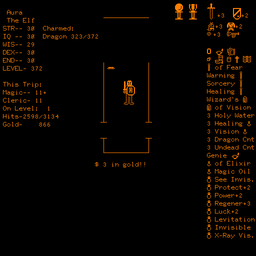Dnd

dnd is one of the first Dungeon Crawling video games, written in 1974-75 by Gary Whisenhunt and Ray Wood for the PLATO Network and based, as its title says, on Dungeons & Dragons. It was the first video game to use bosses as well as the Ur Example of the genre that would later be known as Roguelikes.
You create a character, by rolling the dice on five stats and choosing a class. Then you enter the Whisenwood Dungeon in search of Plunder and the Orb.
Being the PLATO Network, the game has graphics, and uses a Three Quarters View similar to the dungeons of The Legend of Zelda, with the walls in top view, and your character in front view. You explore the dungeon, fighting monsters and collecting treasure. At the end of each level is a Mini Boss guarding a teleporter to the next level.
You can leave the dungeon to rest, and use your treasure to buy items from a weapons shop and a magic shop. On your way back in, the teleporters let you skip completed levels.
At the end of the last level is the Final Boss, the Golden Dragon, who guards the Orb.
Later versions added more dungeons, a Grail to collect in addition to the Orb, and more monsters and items.
dnd inspired several more PLATO games, including Avatar and moria. Daniel Lawrence ported dnd to the PDP-10 minicomputer, and from there to 8-bit microcomputers as Telengard.
- Three Quarters View
- An Adventurer Is You
- An Economy Is You: Aumakua's Alchemy and Korona's Armory.
- Character Level
- Class and Level System
- Critical Existence Failure
- Dungeon Crawling
- Final Boss: The Golden Dragon. The Ur Example.
- Hit Points
- Heroic Fantasy
- Honest Rolls Character
- Level Grinding
- MacGuffin: The Orb.
- Mini Boss: Guarding the entrance to the next level.
- Our Dragons Are Different
- Plunder
- Roguelike: The Ur Example.
- Role-Playing Game: The first RPG videogame that still survives.
- The Six Stats: Minus Charisma.
- Trauma Inn: Rest when you leave the dungeon.